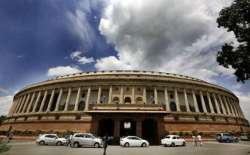Sansad Bhavan to be revamped; all MPs to get separate offices
The government of India has ordered a major revamp of the iconic Sansad Bhavan - the temple of Indian democracy. Parliament House Building will see massive renovation where all the MPs (Lok Sabha + Rajya Sabha) will have a one-room office to carry day-to-day work.

The government of India has ordered a major revamp of the iconic Sansad Bhavan - the temple of Indian democracy. Parliament House Building will see massive renovation where all the MPs (Lok Sabha + Rajya Sabha) will have a one-room office to carry day-to-day work.
The iconic Parliament House Building (popularly known as the Sansad Bhawan)in New Delhi is all set for a major revamp. The Housing And Urban Affairs ministry-led by Hardeep Singh Puri announced this project.
The project aims to carry forward the vision of Prime Minister Narendra Modi who wants it to be completed by 2024. India is slated to host the United Nations Development Program conference in 2025. Top world leaders are likely to attend the conference.
The Central Public Works Department (CPWD) has been asked to undertake the mammoth exercise. CPWD has been asked to utilise space and maintain symmetry in the central vista.
Not only that, but the CPWD has been also asked to create a district township for the government for a modern ecological state. According to the new plan, the government will do away with old buildings like -- Nirman Bhawan, Krishi Bhawan, Udyog Bhawan, Shastri Bhawan and Rail Bhavan.
North and South Block, the seat of some top offices at the Raisina Hills, will also be renovated to make it earthquake-proof. The whole structure will not be disturbed because of its heritage value. The Modi government also aims to shift the key offices in the North and South Blocks. The employees working here will be shifted to a nearby office that will be at walking distance.
To carry the task, CPWD will invite international firms. A final decision on this will be taken by Diwali.
The History of Parliament House
The Sansad Bhavan, which houses the Rajya Sabha and Lok Sabha, was inaugurated in 1927.
Originally called the House of Parliament, Sansad Bhavan was designed by the British architects Sir Edwin Lutyens and Sir Herbert Baker in 1912-1913 as part of their wider mandate to construct a new administrative capital city for British India.
The 85-year-old structure widely suffers from a shortage of space when it comes to day-to-day functioning. During Parliament sessions, the MPs find it difficult to carry out their office works and keep their papers as they don't have a separate room.
However, the Parliament building needs to be protected because of its heritage tag. On August 5th 2019 the Vice president and chairperson of the upper house (Rajyasabha) Venkaiah Naidu proposed to Prime Minister Narendra Modi to have a new building for the Parliament. PM Modi is also keen to take it forward.
The proposal is to create a separate building inside the Parliament House premises that will be used to allocate every MP (545 Lok Sabha and 245 Rajya S Sabha Members) one room and another separate room for an office.
Currently, these MPs sit in Parliament's Central Hall. Prime Minister Narendra Modi is also taking a keen interest in the whole process. PM on his visit to China and Washington discussed the issue at length with architects and historians there.
PM's felt that officers come and go for meetings from one office to another office - they face huge traffic - fuel wastage - pollution- time management.
The new plan will be designed with several tunnel and skywalks.
Here are some of the changes Delhi can look forward to:
- With the redevelopment of General Purpose Office Accommodations (GPOAs) – like Udyog Bhawan, Nirman Bhawan, Krishi Bhawan and Shastri Bhawan, the government is working on developing a common central secretariat in the Central Vista area.
- The Parliament building, following the revamp, will only be used for the sessions of the Lok Sabha and the Rajya Sabha, and the Speakers' office.
- With the development of the Parliament building, all 545 MPs and 200 Rajya Sabha members will be allotted chambers. As of now, separate chambers are allotted only to the Parliament committee chairman, whereas the MPs sit in the central hall, an area which is used for leisure.
- The aim of the mega project is to utilise the space and maintain a symmetry in the Central Vista, where the North and South blocks will be the museums of colonial history
- According to the CPWD, the North and South Blocks are not designed to survive earthquakes. Hence, the buildings will be equipped with advanced technology, similar to the Parliament building in New Zealand.
- The ITO at Delhi's Pragati Maidan will be the new place for international conferences as the trade fair has been moved to Dwarka.
- The work on demolition of old halls in the national capital has already begun, while the new halls will be ready by 2022, where the UNDP conference is slated to be held three years later.
- Few helipads will be constructed, that will enable the VIPs to directly land at the venue from their respective states.
- Tunnels and skywalks will be constructed around the secretariat complex that will enable MPs and MLAs to escape traffic office and reach on time.
- Buildings like the Rail Bhawan and the Bapu Bhawan will not be demolished, but would undergo development, basically the interiors would be revamped.
- Located near India Gate, Hyderabad house and Baroda house will not be demolished.